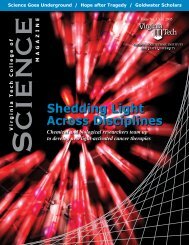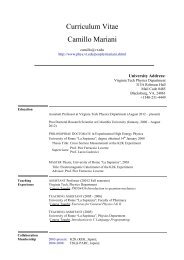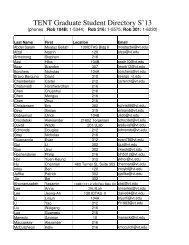Springer Lecture Notes in Physics 716
Springer Lecture Notes in Physics 716
Springer Lecture Notes in Physics 716
Create successful ePaper yourself
Turn your PDF publications into a flip-book with our unique Google optimized e-Paper software.
7 Field-Theory Approaches to Nonequilibrium Dynamics 297<br />
As we will see <strong>in</strong> Subsect. 7.1.5, there are only two <strong>in</strong>dependent static<br />
critical exponents. Consequently, it must be possible to use the static scal<strong>in</strong>g<br />
hypothesis (7.2) or (7.3), along with the def<strong>in</strong>ition (7.1), to express the<br />
exponents describ<strong>in</strong>g the thermodynamic s<strong>in</strong>gularities near a second-order<br />
phase transition <strong>in</strong> terms of ν and η through scal<strong>in</strong>g laws. For example, the<br />
order parameter <strong>in</strong> the low-temperature phase (τ < 0) is expected to grow<br />
as 〈S〉 ∼ (−τ) β . Let us consider Eq. (7.2) <strong>in</strong> the limit |x| → ∞.Inorder<br />
for the |x| dependence to cancel, ˜C± (y) ∝|y| d−2+η for large |y|, and<br />
therefore C(τ,|x| → ∞) ∼ ξ −(d−2+η) ∼ |τ| ν(d−2+η) . On the other hand,<br />
C(τ,|x| →∞) →−〈S〉 2 ∼−(−τ) 2β for T < T c ; thus we identify the order<br />
parameter critical exponent through the hyperscal<strong>in</strong>g relation<br />
β = ν (d − 2+η) . (7.4)<br />
2<br />
Let us next consider the isothermal static susceptibility χ τ , which accord<strong>in</strong>g to<br />
the equilibrium fluctuation–response theorem is given <strong>in</strong> terms of the spatial<br />
<strong>in</strong>tegral of the correlation function C(τ,x): χ τ (τ) =(k B T ) −1 lim q→0 C(τ,q).<br />
But Ĉ±(p) ∼ |p| 2−η as p → 0 to ensure nons<strong>in</strong>gular behaviour, whence<br />
χ τ (τ) ∼ ξ 2−η ∼|τ| −ν(2−η) , and upon def<strong>in</strong><strong>in</strong>g the associated thermodynamic<br />
critical exponent γ via χ τ (τ) ∼|τ| −γ , we obta<strong>in</strong> the scal<strong>in</strong>g relation<br />
γ = ν (2 − η) . (7.5)<br />
The scal<strong>in</strong>g laws (7.2), (7.3) as well as scal<strong>in</strong>g relations such as (7.4) and<br />
(7.5) can be put on solid foundations by means of the RG procedure, based on<br />
an effective long-wavelength Hamiltonian H[S], a functional of S(x), that captures<br />
the essential physics of the problem, namely the relevant symmetries <strong>in</strong><br />
order parameter and real space, and the existence of a cont<strong>in</strong>uous phase transition.<br />
The probability of f<strong>in</strong>d<strong>in</strong>g a configuration S(x) at given temperature<br />
T is then given by the canonical distribution<br />
P eq [S] ∝ exp (−H[S]/k B T ) . (7.6)<br />
For example, the mathematical description of the critical phenomena for an<br />
O(n)-symmetric order parameter field S α (x), with vector <strong>in</strong>dex α =1,...,n,<br />
isbasedontheLandau–G<strong>in</strong>zburg–Wilson functional [1–6]<br />
∫<br />
H[S] = d d x ∑ [ r<br />
2 [Sα (x)] 2 + 1 2 [∇Sα (x)] 2<br />
α<br />
+ u 4! [Sα (x)] ∑ ]<br />
2 [S β (x)] 2 − h α (x) S α (x) , (7.7)<br />
β<br />
where h α (x) is the external field thermodynamically conjugate to S α (x),<br />
u>0 denotes the strength of the nonl<strong>in</strong>earity that drives the phase transformation,<br />
and r is the control parameter for the transition, i.e., r ∝ T − T 0 c ,
















